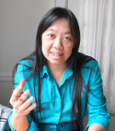
Ellen Do
Georgia Tech, NUS
Keynote: Creative Design Computing for Happy Healthy Living
Time: October 29th at 13:45
Abstract
The age of ubiquitous/pervasive/ambient computing is upon us. We see more and more connected objects and devices embedded in everyday life. Design and Human-Computer Interaction are crucial components of information technologies that color our experience. As designers and technologists, we have the unique opportunity to imagine, design and create interesting, intelligent and interactive technologies for a smart living environment.
A smart living environment is responsive, reconfigurable and transformable, embedded with sensors and actuators, to support everyday happy, healthy living with things that think, spaces that sense and places that play. Specifically, we see opportunity for investigating creative design computing to consider the built environment as an interface. We aim to engage people in playful, creative ways in which computing technologies embedded in the built environment (e.g., objects, furniture, building, and space) can support everyday happy healthy living.
We build wellness technologies in different scales (e.g., in human-centered view: hand, body and environment), for various applications (e.g., to support emotional, physical, and intellectual wellness) to unlock human potential and augmenting human capabilities through digital design innovations. Opportunities exist for integrating multidisciplinary perspectives together to create innovation with impacts.
For example, the Mobile Music Touch, a light-weight fingerless instrumented glove provides passive haptic learning of piano playing but also works as an effective rehabilitation tool. The ClockMe system, not only converts traditional pencil-and-paper Clock Drawing Test on a digital tablet for automatic scoring and analysis for detection of Alzheimer’s disease and related disorders but also provides more information of the drawing behavior such as drawing sequence and pressure. The Digital Box and Block Test employs image processing to automatically detect and record a clinically validated post-stroke rehabilitation assessment for in-home use and a tangible gaming system to increase patient motivation.
The Dodo game provides pictures of cute animals for color matching, and serves as a clinical screening test to detect color deficiency in young children. The Taste + bottle and spoon provide stimulation to alter the sense of taste without any chemical flavoring using electric pluses and color LED lights. It could encourage water drinking or enhance taste for people with restrictive diets or diminished taste sensations. The Sensorendipity is a real-time smartphone-based web-enabled sensor platform for designers to create sensor-based applications such as monitoring activities, in exergaming or safe driving.
Now is an exciting time to engage in creative design computing, to implement physically and computationally enhanced environment, to explore experience media, to build prototypes, towards a smart living environment. Advancing technology offers new ways to solve problems, discover opportunities, and create new objects and experience that delight our senses and improve the way we live and work. Let’s begin with the spark of creativity and enthusiasm and follow up with design and computational thinking towards the goal of creating unique technology for everyone.
Bio
Ellen received a Bachelor degree of architecture (Honors) from National Cheng-Kung University – NCKU in Taiwan, with a minor in Urban Planning, a Master of Design Studies from the Harvard Graduate School of Design – GSD, and a Ph.D. in design computing from Georgia Tech, with a minor in cognitive science & computer science. Ellen has built creative computing tools, from understanding the human intelligence and creativity involved in the design process to improving our interaction with computers beyond the desktop into the physical world. Ellen’s research interests are in: (1) computer aided architectural design, especially sketch computing, (2) creativity and design cognition, including creativity support tools and design studies, (3) tangible and embedded interaction, including architectural robotics and augmented learning, and most recently (4) computing for health, including experience media for wellness technologies.
